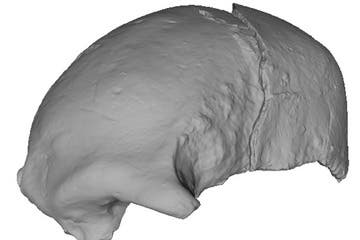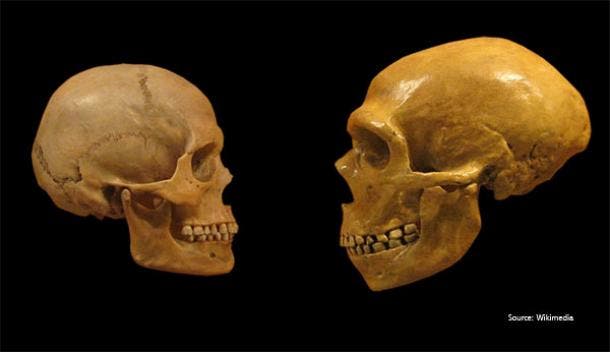
The skull, shown here in a 3D scan, shows subtle differences from similar-age skulls found in both Africa and Europe. Credit: copyright President and Fellows of Harvard College
A partial skull fragment found in Kenya seems to indicate that early humans were much more diverse than previously thought. The 22,000-year-old skull clearly belongs to a human species, but is unlike anything else previously discovered.
New Humans
“It looks like nothing else, and so it shows that original diversity that we’ve since lost,” said study co-author Christian Tryon, a Paleolithic archaeologist at Harvard University’s Peabody Museum in Cambridge, Massachusetts. “It’s probably an extinct lineage.”
The site in Kenya actually shows great promise, as it was likely inhabited for over 20,000 years. Archaeologists not only found this interesting skull, but also one which was 2 times older – 46,000 years old.
About 12,000 years ago, humans began farming, establishing permanent settlements and developing cultures. They also started leaving things behind, so we can now interpret them. But we know very little of the human populations who lived over 12,000 years ago.
There are currently at least ten known species of modern humans, including Neanderthals, the “hobbits“, the Denisovans and the Red Deer Cave People. We only have a basic understanding of this diversity and how different human lineages interacted and impacted each other.
Found in a museum
To get a better understanding of this, Tryon and his colleagues took a second look at specimens in the collections of the National Museums of Kenya in Nairobi. The artifacts were lying around since the 1970s. Sadly, it’s very common for vast parts of museum collections to be under-analyzed and under-studied, due to lack of human and financial resources (this is common even in Western Europa and the US).
The team first conducted several basic measurements on the skull fragment, and then dated it with carbon isotopes, something which wasn’t available when the skull was first discovered. They learned that the skull was 22,000 years old and then compared it it with skulls from Neanderthals, several other fossil human skulls from the same time and other periods, as well as some contemporary humans.
The skull clearly belonged to a Homo sapiens, but it has several distinctive features, suggesting greater genetic diversity than previously thought; its dimensions were markedly different from those of both the European skull and the African skulls from the same time, and the skull was also thickened, although this could be attributed to physical damage, nutritional deficiencies or a very active childhood.
Genes and art
At this Kenyan site, archaeologists also found beads made from ostrich eggs, something very rare at that point in time. The findings come at a crucial point in human history; anthropologists and geneticists estimate that between 20,000 and 50,000 years ago, people began intensively using elaborate trading routes over vast distances, started the first works of art, made the first arrow-like stones and even developed jewelry.
This rediscovery captures a juncture in time and shows that there was a time in recent history when the human species underwent accelerated genetic evolution. There are likely other, as of yet undiscovered genetic variations. Unfortunately, an extremely small sample size is the reality when you’re working with this type of fossils.
Journal Reference: Christian A. Tryon et al. Late Pleistocene age and archaeological context for the hominin calvaria from GvJm-22 (Lukenya Hill, Kenya). doi: 10.1073/pnas.1417909112










